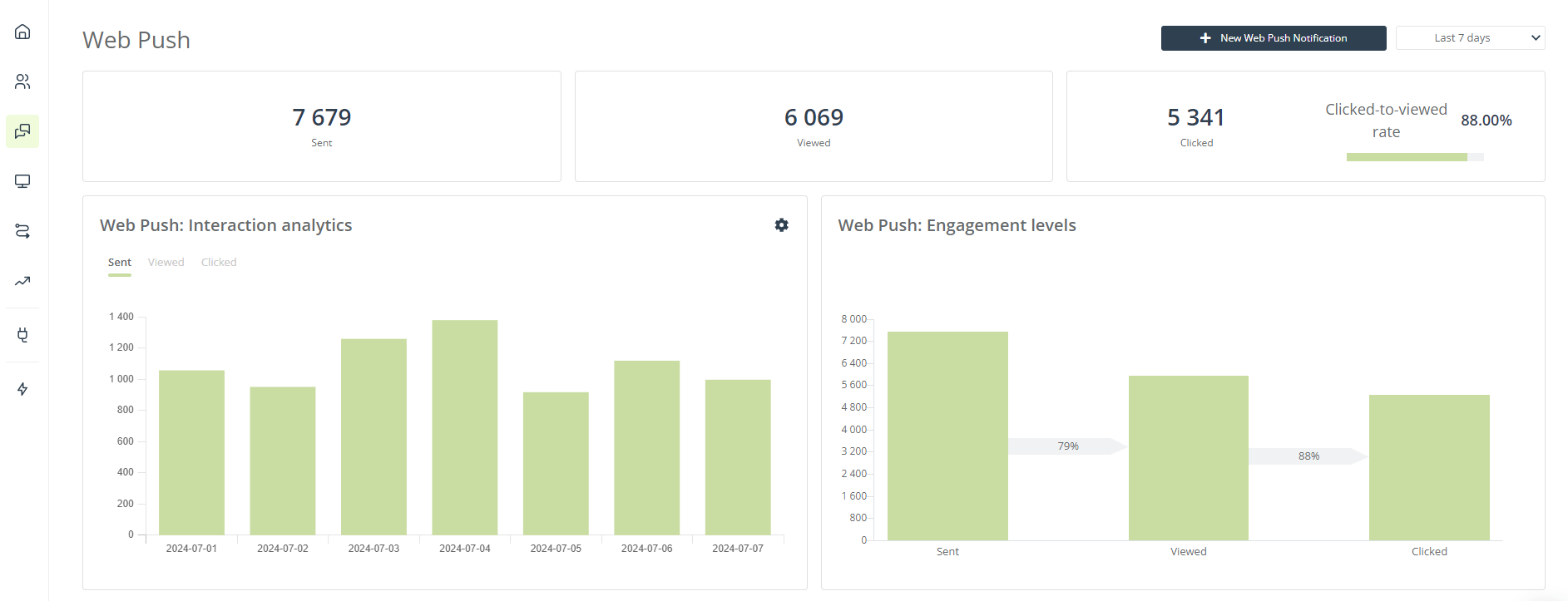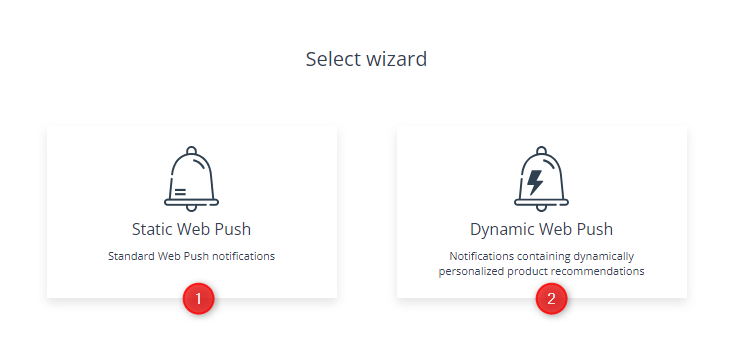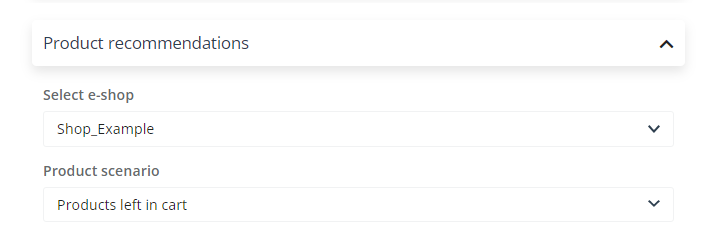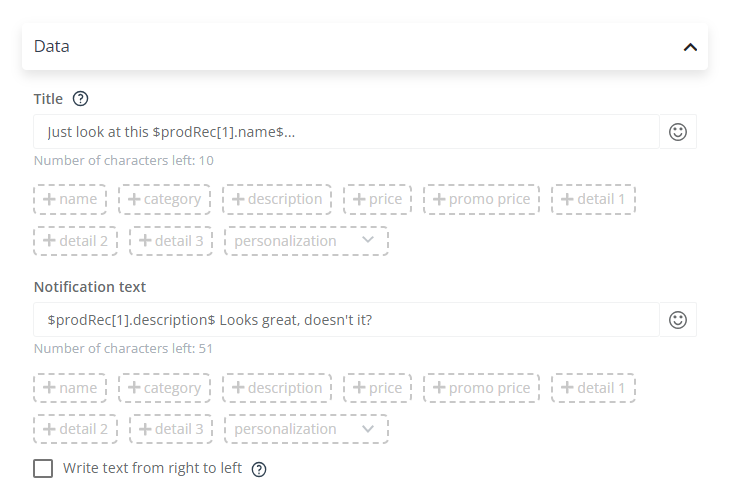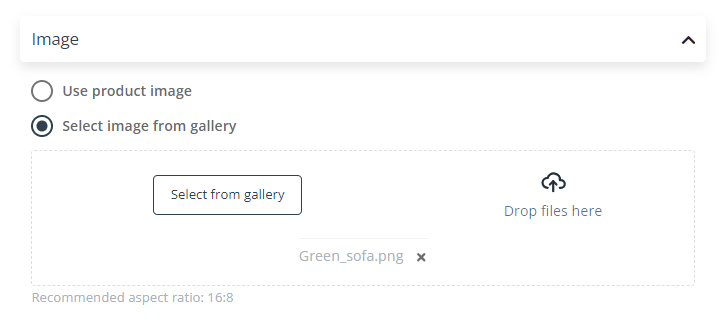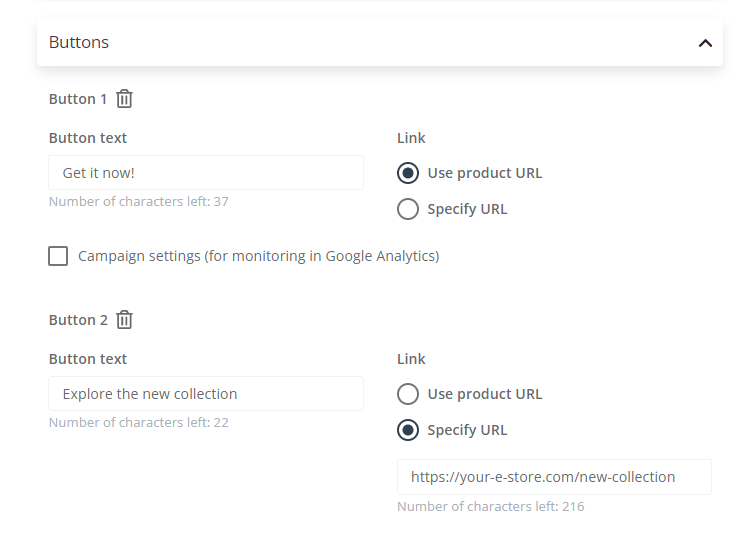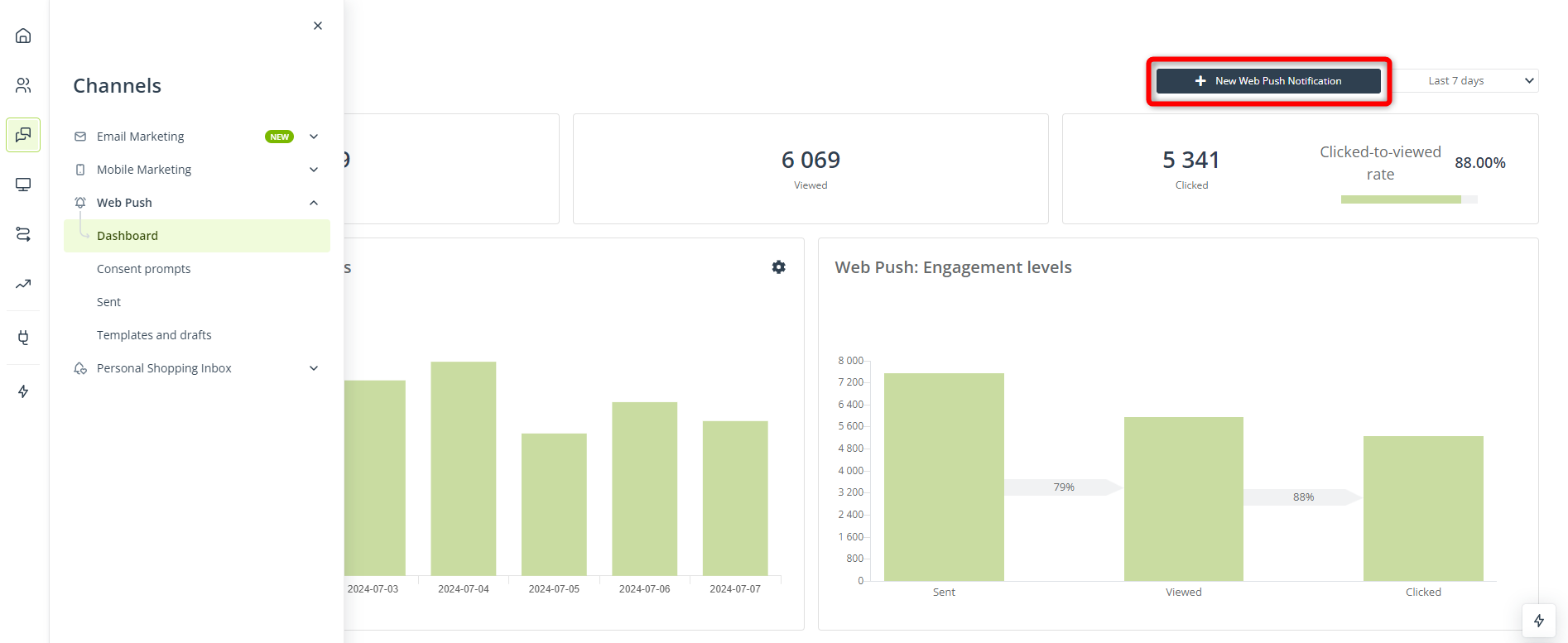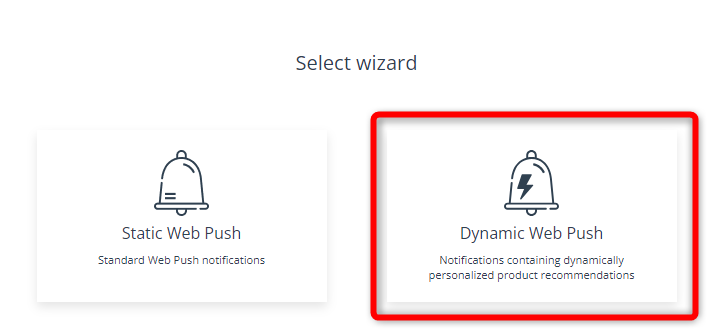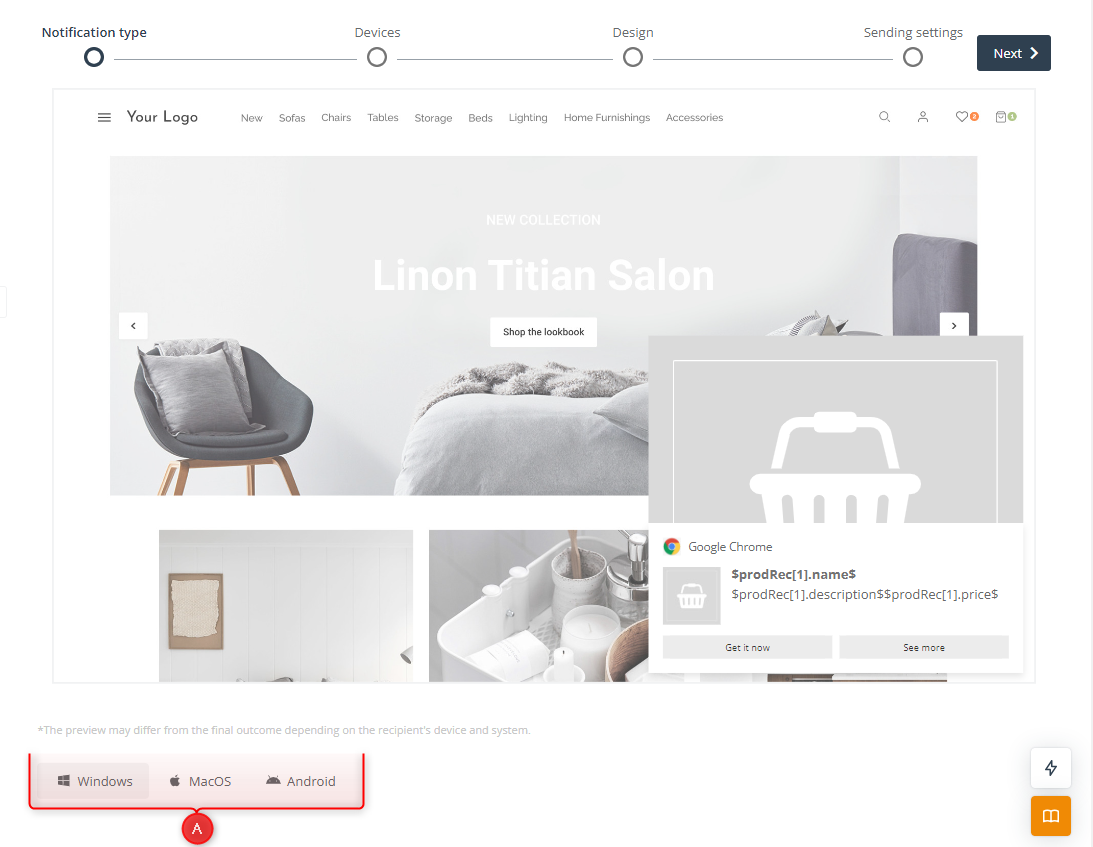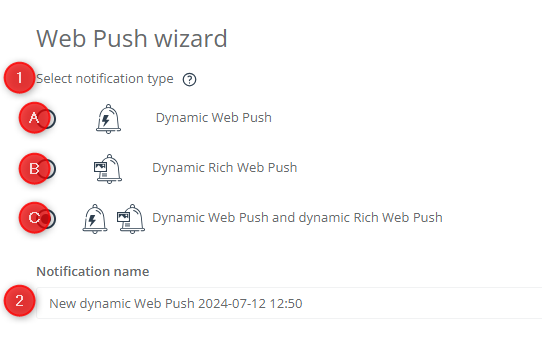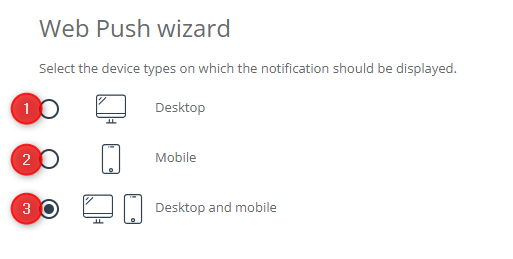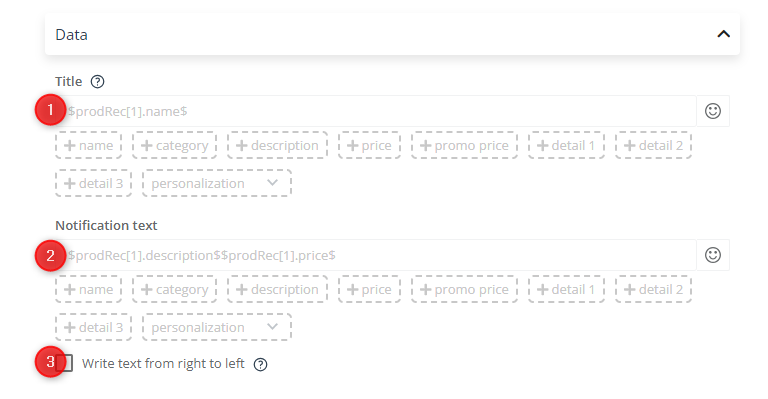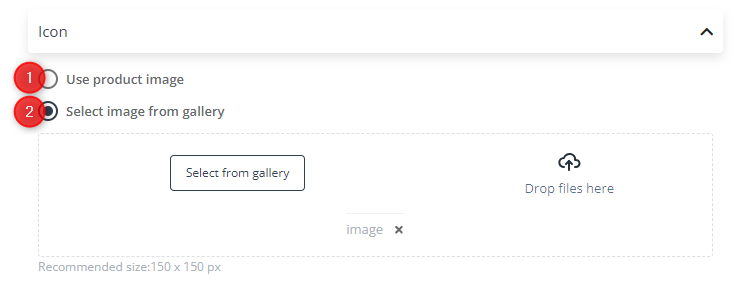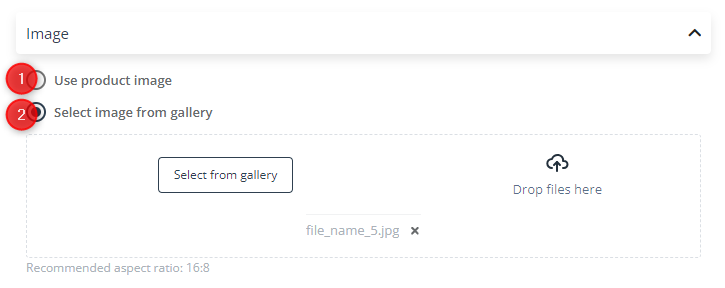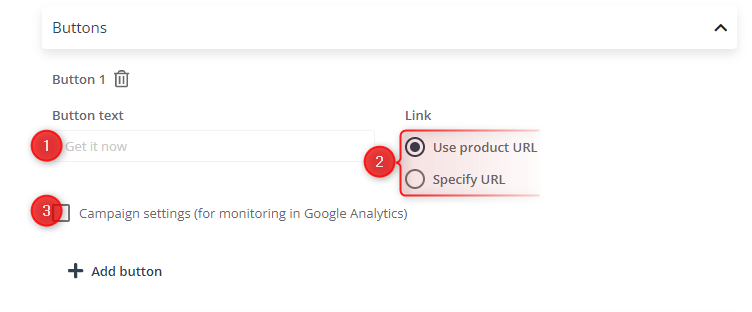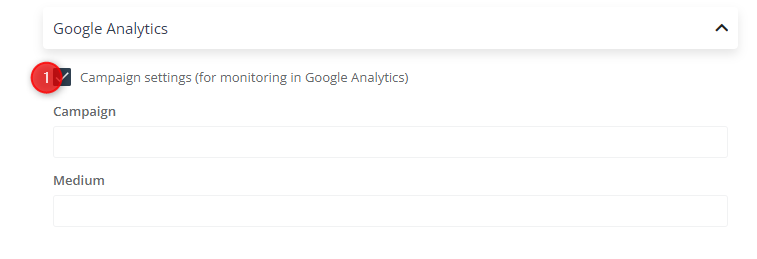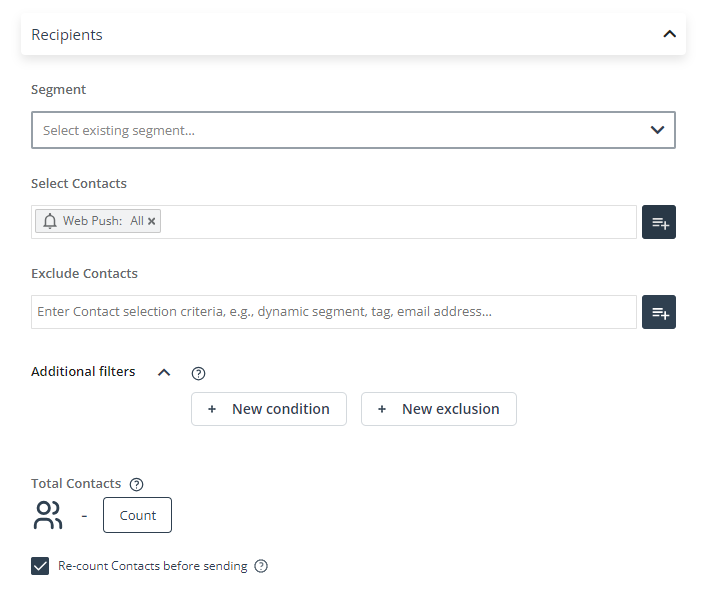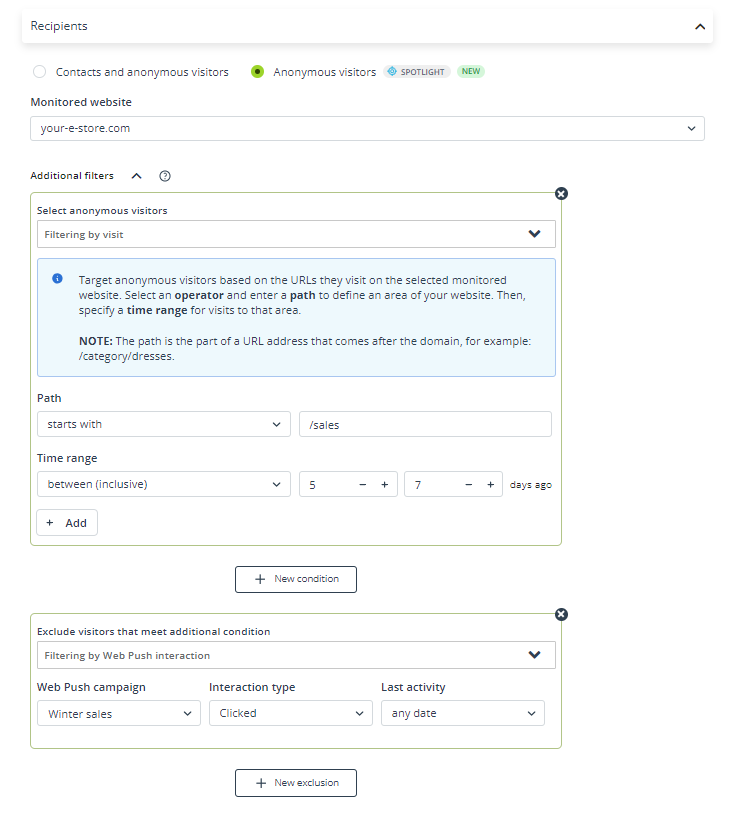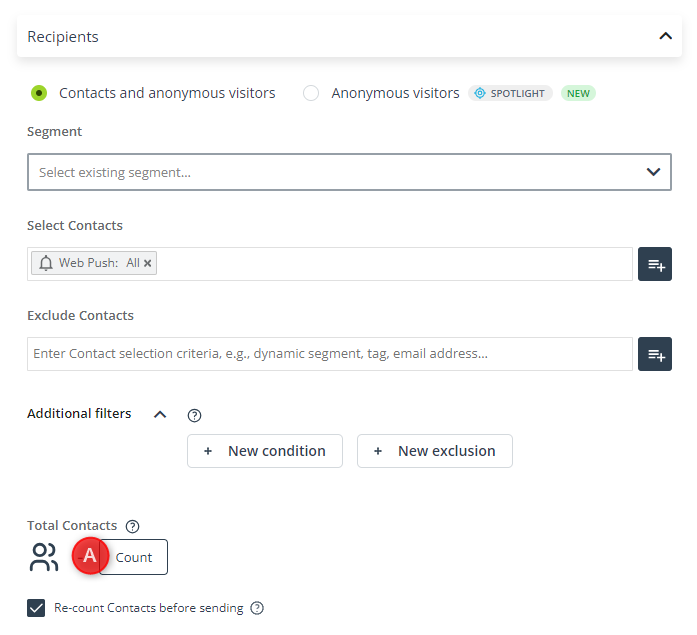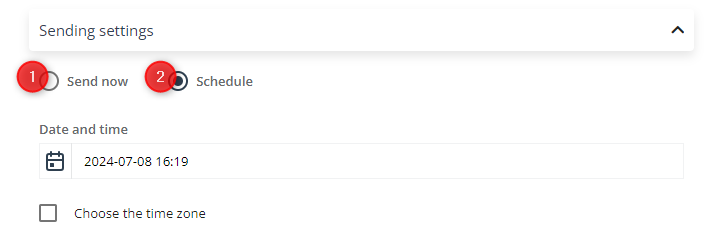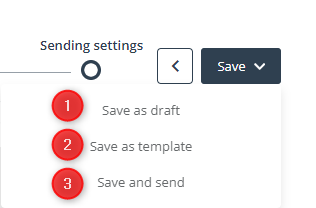Web Push notifications are an important tool for enhancing customer engagement and driving sales. These short messages, handled by browsers and displayed directly on users’ devices, can be sent both to Contacts and anonymous visitors. With SALESmanago, you can effortlessly create eye-catching Web Push notifications tailored to your needs.
The SALESmanago platform offers two Web Push notification wizards: one for static and one for dynamic notifications. This article explains how to create a dynamic Web Push notification—one including dynamically personalized product recommendations. Recommendations matched to the needs and interests of individual website visitors tend to be more effective, allowing you to increase your marketing and sales results.
To create a static Web Push notification, go to
Channels → Web Push → Dashboard or Sent or Templates and drafts → + New Web Push Notification → Dynamic Web Push
Contents
- Getting started
- Notification elements that can be dynamically personalized
- Create a Dynamic Web Push notification
- Save a Dynamic Web Push notification
1. Getting started
Web Push notifications are an important marketing tool allowing you to easily reach a broad audience. The Web Push channel offers a number of advantages, including the following:
- Web Push notifications are sent for free.
- Web Push notifications appear directly on the recipient’s screen, even if they have not opened their browser.
- You do not need to collect any personal data to show Web Push notifications. This type of messages can be sent not only to Contacts, but also anonymous visitors.
Remember, however, that you can send Web Push notifications only to people who have agreed to receive them. Before creating a Web Push notification, first, create or configure a Web Push consent prompt.
Read more about Web Push consent prompts >>
SALESmanago’s Web Push notification wizards are intuitive tools that allow you to create effective and visually appealing communications step by step. You can choose between two wizards:
[1] Static Web Push—Create a notification with fixed content (the same content for all recipients). Static notifications cannot include dynamic product recommendations, however, both the title and the content can be personalized with placeholders.
[2] Dynamic Web Push—Create a notification that features personalized recommendations tailored to individual recipients based on their behaviors. This type of notifications works especially well with automated campaigns (Workflow, WebFlow, and Automation Rules), as the recommendation can be a direct response to a specific action of a Contact or anonymous visitor.
A standard notification, either static or dynamic, consists of an icon accompanied by text and one or more buttons. Additionally, in both these wizards, you can create a Rich Web Push notification, which contains an additional image. Note, however, that Rich Web Push notifications are not supported by all devices and browsers.
This article concerns the dynamic Web Push wizard. To learn more about the static Web Push wizard, read this article >>
2. Notification elements that can be dynamically personalized
Just like the static Web Push notification, the dynamic one can be personalized with placeholders for Contact data, such as $name.p1$, $city$ or $cst.dictionary_detail_name.dictionary_property$.
Read more about personalization using placeholders >>
In addition to this, dynamic Web Push notifications can be personalized with product recommendations matched based on behavioral data (visits—for all website visitors, carts and purchases—for Contacts only) or zero-party data (indications in the Preference Center—for Contacts only). This means that each recipient will see a different product recommendation in their notification.
Such dynamic personalization can be implemented in the following elements of a dynamic notification:
- Title,
- Main content,
- Icon,
- Image (Rich Web Push only, available under the Rich Web Push tab in Step 3 of the wizard),
- Links (the destination URL for each button and for the entire clickable notification area).
The data and graphics will be automatically loaded from the e-store (Product Catalog or XML Product Feed) selected in Step 4 of the wizard (Sending settings), based on the recommendation scenario selected in the same section:
The important thing is that only one product can be recommended in a single Web Push notification. This means that all placeholders (both for text and graphics) will be replaced with data concerning the same product. If you decide to personalize both the icon and the image, they will both be replaced with the same picture of the same product.
To personalize the text content (title and main content), insert special placeholders as required. You can do this very easily by clicking first the input field and then one of the placeholders listed below. The placeholders can be accompanied by static (fixed) text, as shown in the screenshot below:
Remember to keep the text as short as possible. Browsers support a very limited number of characters in Web Push notifications. The limit for the title is 48 characters, and the limit for the main content is 100 characters. The product details that will be dynamically loaded from your e-store can be long, especially the name and the description. Bear this in mind when creating your text content, and especially when adding any static text.
TIP: Notice that placeholders for Contact data are available under the Personalization dropdown.
To personalize the graphics (icon and image), select the option: Use product image.
If you select the option: Select image from gallery, you will be able to select a static image that will be the same for all recipients. The recommended aspect ratio is 2:1, for example, 1000:500 px.
Remember that if you decide to personalize both the icon and the image (top banner), they will both be replaced with the same picture of a single product. Therefore, the recommended option is to use a static image and a dynamic icon, for the following reasons:
- Using the same product picture for both the top banner and the icon might look unprofessional.
- Most product images are square, which causes some parts of the banner to be cropped.
- Some browsers do not support Rich Web Push and so the top banner may not be displayed at all. Therefore, it makes more sense to display the product picture as the icon.
To personalize the links, in their respective settings, select the option: Use product image.
If your notification includes two buttons, the recommended option is to use a dynamic link for one of them and a static link for the other, as presented in the screenshot below:
3. Create a Dynamic Web Push Notification
IMPORTANT: Before you can create a Web Push notification, you need to create or configure a Web Push consent prompt. Read more about Web Push consent prompts >>
To create a dynamic Web Push notification, go to Menu → Channels →Web Push → Dashboard → + New Web Push Notification.
Then, select the dynamic Web Push wizard.
The dynamic Web Push wizard consists of four steps, which are described in detail below.
As you work on your new notification, you can see its preview and all your changes on the right side of the screen. Note that you can switch between previews for different systems [A].
A. Notification type
[1] Dynamic Web Push type—Here, you can define the type(s) of notification you want to create.
You can create a simple dynamic Web Push notification [A], consisting of an icon, text, and one or two buttons, or a dynamic Rich Web Push notification [B], which additionally includes an image. You can also choose to create both these notification types at once [C]. The last option allows you to ensure the correct display of your notification to all recipients, as certain devices and systems support only Web Push, but not Rich Web Push. If you select option [C], whenever it is impossible to display a Rich Web Push notification, a simple notification will be displayed instead.
[2] Notification name—Provide a name for your notification that will allow you to easily identify it in the system.
B. Devices
In this step, you can select the device types on which your notification will be displayed.
You can select Desktop [1] to display the notification on desktops and laptops, Mobile [2] to display it on tablets and smartphones, or Desktop and mobile [3], for all these device types.
By creating separate notifications for desktop and mobile devices, you can adjust your communications to different screen sizes and better target your recipients.
Note that on the right side of the screen, you can switch between previews for different systems.
C. Design
In Step 3, you can create the content of your notification.
If you selected Web Push and Rich Web Push in Step 1, here, in Step 3, you will be able to switch between the two and design them separately.
IMPORTANT: Any changes made under the Web Push tab [A] will be applied to the Rich Web Push tab [B]. For example, the title entered in tab [A] will be copied to tab [B]; if you remove a button in tab [A], it will be removed from tab [B], too. However, any changes made in tab [B] will have no effect on tab [A] and will be applied to Rich Web Push only.
- Data
[1] Title—Provide a title for your notification. The title will be visible to your recipients. The character limit is 48 (which is the maximum number supported by browsers). You can add emoticons or personalize the title with placeholders pulling data from the Contact Card, such as “name” (this will only work for Contacts). However, when creating a dynamic notification, you can also use placeholders that will pull the relevant data from the selected e-store (Product Catalog or XML Product Feed).
For example, if you complete this field as follows:
Instead of the placeholder: $prodRec[1].name$, each recipient will see the name of a different product (based on their individual behavioral data).
If you want to use placeholders, remember to keep any other text as short as possible, as the values loaded from your e-store may be long themselves.
Read more about personalization using placeholders >>
NOTE: Before sending a Web Push notification with custom characters, emoticons or placeholders, send a test notification to see if everything is displayed correctly.
[2] Notification text—Provide the main content of your notification. The character limit is 100. You can add emoticons or personalize the text with placeholders pulling data from the Contact Card, such as “name” (this will only work for Contacts). However, since you are creating a dynamic notification, you can also use placeholders that will pull data from the selected Product Catalog or XML Product Feed. For example, you can use this field to display the original price and the discount price of a product.
If you want to use placeholders, remember to keep any accompanying text as short as possible, as the values loaded from your e-store can be long themselves.
[3] Write text from right to left—Enable this option if you want the text to be written from right to left. Note that the actual way in which the text will be displayed depends largely on the language settings of the recipient’s device.
- Icon
In this step, you can replace the default SALESmanago icon with your own image.
[1] Use product image—Select this option if you want to display a product image loaded from your e-store as the icon.
[2] Select image from gallery—Add a static icon to your notification by selecting a previously uploaded file from your gallery or dragging an image stored on your desk and dropping it directly here.
The accepted image formats include: JPG, PNG, and WebP. Note that GIF format is not supported by browsers. The suggested icon size is 150×150 px.
TIP: Use WebP format for both photos and images with a transparent background to speed up the loading time while preserving high quality.
- Image (Rich Web Push only)
In this section, you can add an image for your Rich Web Push notification. Note that this section is only visible if you are creating a Rich Web Push or both Web Push and Rich Web Push.
[1] Use product image—Select this option if you want to display a product image loaded from your e-store as the image at the top of the notification.
[2] Select image from gallery—Add a static image to your notification by selecting a previously uploaded file from your gallery or dragging an image stored on your desk and dropping it directly here.
The accepted image formats include: JPG, PNG, and WebP. Note that GIF format is not supported by browsers. The suggested aspect ratio of the notification image is 16:8 (horizontal), for example: 2000×1000 px or 1000×500 px.
NOTE: The appearance of Dynamic Web Push and Dynamic Rich Web Push notifications is strongly dependent on the recipient’s browser and operating system. For example, MacOS does not support Rich Web Push notifications.
- URL address
[1] Use product URL—Select this option if you want the entire clickable area of the notification to automatically link to the page of the displayed product. If the recipient clicks anywhere on the notification (except for buttons), they will be redirected to this product’s URL address.
[2] Specify URL—Specify a static redirection URL for the entire clickable area of the notification. The character limit is 255.
- Buttons
In this section, you can add one or two buttons to your notification. Buttons are optional, and some browsers do not support them at all.
[1] Button text—Enter the text (preferably, a call to action) that will be displayed on the button. The character limit is 48.
[2] Link—Use the product URL or specify the URL address to which the recipient will be redirected if they click the button. The character limit is 255.
[3] Campaign settings (for monitoring in Google Analytics)—Check this box if you want to add parameters that will allow you to monitor your marketing results in Google Analytics.
If you check this box, two new fields will appear. Specify the value of the utm_campaign and/or utm_medium parameters.
The parameters specified here refer to buttons only. If the recipient’s browser does not support buttons on notifications, then these parameters will not be used.
IMPORTANT: Adding buttons is optional. Not all browsers support actionable buttons. Here is a description of the capabilities of the most popular browsers in this regard:
- Chrome: Chrome supports up to two action buttons per notification.
- Firefox: While Firefox supports Web Push notifications, it does not support buttons within these notifications. Any buttons will be replaced with a “close” button in the language of the browser, so consider including a clear CTA in the content of the notification.
- Safari: Safari supports Web Push notifications on macOS, but does not support buttons within these notifications. Consider including a clear CTA in the content of the notification.
- Opera: This browser supports up to two action buttons per notification.
Note that SALESmanago does not support Web Push notifications for Edge.
- Google Analytics
[1] Campaign settings (for monitoring in Google Analytics)—Check this box if you want to add parameters for monitoring your marketing results in Google Analytics.
When you check this box, two new fields will appear. Specify the value of the utm_campaign and/or utm_medium parameters.
The parameters specified here refer to the entire clickable area of the notification, except for buttons, for which you can set their own parameters (see above).
- Select language
Once you have finished creating your notification in the default language, you can create different language versions of the same notification.
To add different languages, click + Add language [1] and select a language from the list. The language in which the notification will be displayed to each individual recipient will be determined based on the language of their browser.
EXAMPLE: You create a notification in three languages: default (which in your case is English), French, and Italian. You send the notification, either as a mass message or via a Workflow process. The recipients who have their browser language set to French will see the French version of the notification; those who use their browsers in Italian will see the Italian version; everyone else will see the default version, in this case, the English one.
If you have more than one language, you can switch between them by clicking their names. Note that the preview on the right side of the screen will change accordingly.
To remove a language, click the trash bin icon. Note that this action will also remove all content created in this language.
D. Sending settings
In the last step, you can select the consent prompt that will be associated with this notification, define the recipients, select the product recommendation scenario, set the sending time, and specify the lifespan (TTL) of the notification.
- Consent prompt
[1] Consent prompt—Dynamic Web Push notifications can only be sent to those website visitors (Contacts and/or anonymous visitors) who have consented to receive them. Web Push consent is collected through dedicated consent prompts. Here, you can select one or more consent prompts based on which this specific Web Push notification will be sent.
The dynamic Web Push notification will be displayed only to those people who have given consent through the consent prompt(s) selected in this section.
Note that selecting the appropriate consent prompt(s) can also be a way to target a specific audience.
- Recipients
These settings allow you to define your audience by specifying the conditions that must be met for a person to receive your notification.
The contents of this section depend on whether you have a Spotlight plan activated for your account. Spotlight is a feature that allows you to target anonymous visitors based on behavioral data.
Read more about the Spotlight feature >>
If you have no Spotlight plan, you will see the following options:
Use the standard SALESmanago selectors and filters to specify the Contacts to whom the notification should be sent.
You can also send the notification to anonymous visitors who have consented to this form of marketing communication—however, without Spotlight, you cannot target them based on their visits and interactions. To include anonymous visitors in your audience, use the Contact selector: Web Push, selecting either All or Anonymous.
IMPORTANT: Any scenarios based on data transferred in External Events (such as PURCHASE or CART) will not work for anonymous visitors. When sending a Web Push notification to anonymous visitors, select a “safe” scenario such as Recently viewed products, which is based on visits. If you want to use scenarios such as Products left in cart or Products matched based on indications in Preference Center, the recommended option is to send the notification separately to Contacts and separately to anonymous visitors, with the configuration adjusted as required.
If you have a Spotlight plan, you can decide whether you want to target Contacts and anonymous visitors [1] or anonymous visitors only [2].
With option [1], the notification will be sent to the Contacts selected using SALESmanago’s selectors and filters and to all anonymous visitors.
With option [2], the notification will be sent only to the specified anonymous visitors. This allows you to precisely target anonymous visitors based on their behaviors. You can select the monitored website and filter anonymous visitors by visits to specific URLs and by interactions with your Web Push notifications.
EXAMPLE: With the following configuration:
The Dynamic Web Push notification will be sent only to anonymous visitors who visited a page on www.your-e-store.com whose URL path starts with “/sales” between 5 to 7 days ago, except for those visitors who clicked a link in the “Winter sales” notification.
Read more about the targeting of anonymous visitors with Spotlight >>
After defining your audience, you can click Count [A] to see the approximate number of recipients to whom the Web Push notification will be sent.
The number displayed after clicking this button is the total number of opt-ins obtained through the selected consent prompt(s), both for monitored Contacts and anonymous visitors. This does not necessarily reflect the actual number of recipients. For example, if a single Contact has granted consent twice, once in Chrome and once in Firefox, this will be counted as 2. If you select two consent prompts in the Consent prompt section and a single Contact has granted consent through both these prompts, this will also be counted as 2.
- Product recommendations
[1] Select e-shop—Select the e-store that will be the source of product recommendations for this notification.
[2] Product scenario—Select the recommendation scenario based on which products will be matched to individual recipients.
IMPORTANT: Any scenarios based on data transferred in External Events (such as PURCHASE or CART) will not work for anonymous visitors. When sending a Web Push notification to anonymous visitors, select the “safe” scenario based on visits: Recently viewed products. If you want to use scenarios such as Products left in cart or Products matched based on indications in Preference Center, the recommended option is to send the notification separately to Contacts and separately to anonymous visitors, with the configuration adjusted as required.
- Sending settings
Choose whether you want to send the notification immediately [1] or schedule it for later [2].
If you choose that you want to schedule your Web Push notification for later, you can specify a date and time and select the time zone.
The settings configured in this section will be applied when you click the Save button and select Save and send.
- Time to Live (TTL)
Specify the period for which the notification will remain valid after being sent [1]. This is the time limit within which the notification can actually be displayed to the recipient. If the specified time elapses before a given recipient has seen the notification, the notification will expire and will not be displayed to this recipient at all.
The maximum TTL is four weeks, however, long TTLs are not recommended. If an intended recipient doesn’t use their device for a week or two, when they eventually turn it on, they are likely to receive a whole bunch of notifications, which they are likely to ignore. Such situations may also cause them to withdraw their Web Push consent.
IMPORTANT: The TTL is measured from the sending time. For example, if you schedule the notification to be sent at 10:30 with a validity period of one hour, the intended recipients will be able to see it between 10:30 and 11:30. If somebody turns on their device at 11:35, they will not receive the notification.
4. Save a Dynamic Web Push notification
After clicking the Save button, you will see a number of options:
You can save your notification as a draft [1] and edit it later to finish your work.
If you save it as a template [2], the notification will be added to the list of templates and you will be able to send or schedule it later. You can also use it in Workflows and Automation Rules (Action: Send Web Push notification).
You can also save the notification as a finished template and immediately send or schedule it [3]. When this option is clicked, the settings configured in the Sending settings section of Step 4 are applied.
IMPORTANT: Before sending a Web Push notification, it is recommended to send a test to ensure that everything looks as intended. Note that the actual appearance of Web Push notifications may depend on the recipient’s operating system and browser.
You can also send Dynamic Web Push notifications through Automation Processes, by using the Action: Send Web Push notification.
Read more about the Workflow Action: Send Web Push notification >>
You can find all your drafts and finished templates by going to Menu → Channels → Web Push → Templates and drafts.
Read more about the list of Web Push templates and drafts >>
To see all your sent notifications, including their analytics, go to Menu → Channels → Web Push → Sent.
Read more about Web Push notification analytics >>
